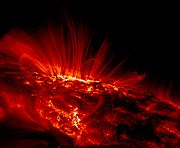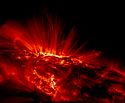TRACE
 Ilustracja przedstawiająca teleskop TRACE na orbicie | |
| Inne nazwy | Explorer 73 |
|---|---|
| Indeks COSPAR | 1998-020A |
| Państwo | |
| Zaangażowani | |
| Rakieta nośna | Pegasus XL |
| Miejsce startu | |
| Orbita (docelowa, początkowa) | |
| Perygeum | 520 km |
| Apogeum | 547,2 km |
| Okres obiegu | 95,48 min |
| Nachylenie | 97,84° |
| Czas trwania | |
| Początek misji | 2 kwietnia 1998 02:43:23 UTC |
| Koniec misji | 21 czerwca 2010 |
| Wymiary | |
| Masa całkowita | 250 kg |
TRACE (ang. Transition Region and Coronal Explorer) – teleskop kosmiczny NASA służący do badania związku pomiędzy polem magnetycznym Słońca a strukturami plazmy, na podstawie zdjęć wysokiej rozdzielczości i obserwacji fotosfery oraz obszarów przejściowych do korony słonecznej. Misja odbyła się w ramach programu Small Explorer (SMEX), stanowiącego część programu Explorer.
TRACE został umieszczony na orbicie za pomocą rakiety Pegasus XL 2 kwietnia 1998. Jedyny instrument naukowy satelity – teleskop Cassegraina o długości 1,6 m posiada zwierciadło o aperturze 30 cm i ogniskowej 8,66 m, które w połączeniu z detektorem CCD 1024×1024 piksele obejmowało obszar 8,5×8,5 minuty kątowej. Rozdzielczość kątowa teleskopu wynosiła 1 sekundę kątową. Cztery panele ogniw słonecznych o całkowitej powierzchni 2 m² były w stanie dostarczyć ok. 220 W energii. Gdy satelita znajdował się w cieniu Ziemi energii dostarczał akumulator niklowo-kadmowy o pojemności 9 Ah.
Misja TRACE zakończyła się 21 czerwca 2010, kiedy to odebrano ostatnie zdjęcie z satelity[1].
Zdjęcie plamy słonecznej wykonane przez TRACE
Przypisy
Bibliografia
- NSSDC Master Catalog (ang.)
Linki zewnętrzne
Media użyte na tej stronie
The flag of Navassa Island is simply the United States flag. It does not have a "local" flag or "unofficial" flag; it is an uninhabited island. The version with a profile view was based on Flags of the World and as a fictional design has no status warranting a place on any Wiki. It was made up by a random person with no connection to the island, it has never flown on the island, and it has never received any sort of recognition or validation by any authority. The person quoted on that page has no authority to bestow a flag, "unofficial" or otherwise, on the island.
Example of solar coronal loops observed by the Transition Region And Coronal Explorer (TRACE), 171 Å filter. These loops have a temperature of approximately 106 K. These loops contrast greatly with the cool chromosphere below.
It was a quiet day on the Sun in September of 2000. The above image from NASA's sun-observing TRACE spacecraft shows, however, that even during "off days" the Sun's surface is a busy place. Shown in ultraviolet light, the relatively cool dark regions have temperatures of thousands of degrees.
A large sunspot group is visible as the bright area near the horizon. The bright glowing gas flowing around the sunspots has a temperature of over one million degrees Celsius (1.8 million degrees Fahrenheit). The high temperatures are thought to be related to the rapidly changing magnetic field loops that channel solar plasma.
A quiet day on the Sun. No spectacular flares or mass ejections, no odd filaments moving, and nevertheless the image of AR 9169, with the much smaller AR 9167 just ahead of it, is very pretty. This image was taken with TRACE in the 171Å passband, showing the bright emission of the gas at about 1 million degrees, with the cooler material around 10,000 degrees showing up as dark, absorbing structures.






